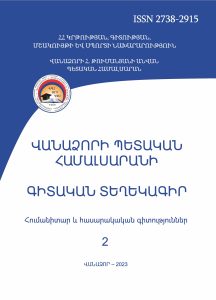On the Possibility of Protecting Metals From Electrochemical Corrosion without an External Power Source
Scientific Proceedings of Vanadzor State University Natural and Exact Sciences (ISSN 2738-2923)
2023 vol 2
On the Possibility of Protecting Metals From Electrochemical Corrosion without an External Power Source
Edik Khachatryan, Vilen Kocharyan
Martun Tovmasyan
Summary

Key words: electrolyte,electric current, electrode potential, cathode, anode, electrochemical protection, galvanic circuit
Electrochemical corrosion of metals is one of the most common and dangerous types of corrosion, causing enormous damage to the national economy. This type of corrosion occurs in all cases, in which metals and alloys come into contact with conductive media.
Anodic and cathodic electrochemical protection are the techniques for shielding metal structures from electrochemical corrosion. In these methods, the metal structure being protected is connected to an external direct current source, and depending on the direction of movement of the electrode potential of the metal (in this case, positive or negative), anodic and cathodic electrochemical protections are distinguished. The use of an external power source makes the process energy-intensive and unprofitable.
This work is based on our previous studies, in which we showed that electrochemical systems, consisting of two electrodes of the same type and a conductive medium also operate in galvanic battery mode and are characterized by low galvanic currents. Given these conditions, we connected the protected object in this medium to another metal of the same name that was either smaller or larger in certain situations in order to prevent electrochemical corrosion of metals, provided that a proper galvanic circuit was formed.
Studies have shown that the corrosion losses of the electrodes in the studied acid environment amounted to only 0.035 g, while the control electrode to – 0.0468 g. Approxiamtely 2 or 3 hours after the start of the experiment, the galvanometer detects the absence of current in the circuit and the system goes into a stable passive state. The mentioned circumstance makes it possible to apply a new method of protecting metals from electrochemical corrosion, which allows it to be carried out without the use of an external current source.
